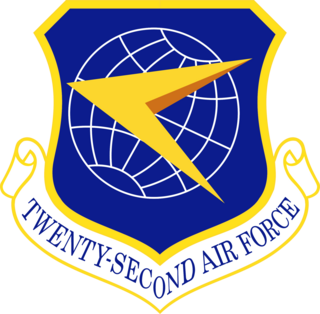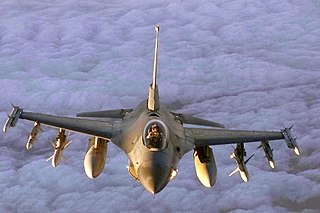
Twenty-Second Air Force is a Numbered Air Force component of Air Force Reserve Command (AFRC). It was activated on 1 July 1993 and is headquartered at Dobbins Air Reserve Base, Georgia.
The Army Air Forces Tactical Center was a major command and military training organization of the United States Army Air Forces during World War II. It trained cadres from newly formed units in combat operations under simulated field conditions around which new combat groups would be formed. It was established as the Army Air Forces School of Applied Tactics (AAFSAT) in 1942 and redesignated the following year.

The 50th Troop Carrier Wing is an inactive United States Air Force unit. The wing was formed in 1941 as the 50th Transport Wing, a headquarters for air transport organizations of the Air Corps. In 1942, it became a training organization for troop carrier units deploying overseas. In 1943, it moved overseas, where its units participated in combat in the Mediterranean and European Theaters of Operations. Following V-E Day it remained in Europe until the fall of 1945. Its last assignment was with Third Air Force at Pope Field, North Carolina, where it was inactivated on 31 July 1946. It was redesignated the 50th Air Division in 1959, but was not activated.

The 478th Aeronautical Systems Wing is an inactive wing of the United States Air Force which was last based at Wright-Patterson Air Force Base, Ohio, where it was inactivated in 2009. The wing was first organized as the 478th Fighter Group, which briefly served as a Fourth Air Force Replacement Training Unit in 1944. The unit was disbanded when the Army Air Forces reorganized its training units into AAF Base Units to reduce manpower requirements in the United States.

The 4th Special Operations Squadron is part of the 1st Special Operations Wing at Hurlburt Field, Florida. It operates Lockheed AC-130J aircraft providing special operations capabilities.

The 1st Airborne Command Control Squadron is part of the 595th Command and Control Group at Offutt Air Force Base, Nebraska. It operates the Boeing E-4 aircraft conducting airborne command and control missions.

The 11th Airlift Squadron is an inactive United States Air Force unit. It was most recently part of the 375th Airlift Wing as Scott Air Force Base, Illinois. It operated McDonnell Douglas C-9 Nightingale aircraft conducting medical evacuation missions.

The 44th Reconnaissance Squadron is a unit of the United States Air Force's 432nd Wing, Air Combat Command stationed at Creech Air Force Base, Nevada, where it operates unmanned aerial vehicles. The squadron is assigned to the 432nd Operations Group, and has been reported to operate the Lockheed Martin RQ-170 Sentinel.

The United States Army Air Forces during World War II had major subordinate Commands below the Air Staff level. These Commands were organized along functional missions. One such Command was the Flying Training Command (FTC). It began as Air Corps Flying Training Command on 23 January 1942, was redesignated Army Air Forces Flying Training Command (AAFTC) on 15 March 1942, and merged with Army Air Forces Technical Training Command to become Army Air Forces Training Command on 31 July 1943. Continuing service after the war, it was redesignated Air Training Command on 1 July 1946. During the consolidation of Air Force Major Commands in the retrenchment of the 1990s, Air Training Command assumed control of Air University and became Air Education and Training Command on 1 July 1993—today's Air Education and Training Command (AETC), which celebrated its 75th anniversary 23 January 2017. see the Lineage and honors statement for AETC.

The 54th Fighter Group is an active unit of the United States Air Force stationed at Holloman Air Force Base, New Mexico and assigned to the 49th Wing of Air Education and Training Command. The group was reactivated in March 2014.

The 28th Expeditionary Air Refueling Squadron is a provisional United States Air Force unit. It was last known to be assigned to the 40th Air Expeditionary Group. Diego Garcia Air Base, British Indian Ocean Territory. Its current status is at Al Udeid Air Base under the 379th Expeditionary Operations Group.

Bolling Air Force Base or Bolling AFB is a United States Air Force base in Washington, D.C. In 2010, it was merged with Naval Support Facility Anacostia to form Joint Base Anacostia–Bolling. From its beginning, the installation has hosted elements of the Army Air Corps and Navy aviation and support elements.

The 10th Airborne Command and Control Squadron is an inactive United States Air Force unit that flew airborne command post aircraft from RAF Mildenhall, England from January 1970 to December 1991. Through a unit consolidation in September 1985, the squadron has roots in units that participated in World War II, the Korean War and the Vietnam War

The South Atlantic Wing, Air Transport Command is a former United States Army Air Forces unit. It was organized in 1942 to ferry aircraft and transport personnel and equipment from the Caribbean to the Mediterranean Theater of Operations, European Theater of Operations, China-Burma-India Theater and for delivery of lend lease aircraft to the Soviet Union. It also transported critical material from South America. The wing commander also served as the United States Army theater commander for South America. After V-E Day, the wing became responsible for the return of aircraft and personnel to the United States. It was inactivated in 1946 as operations in the South Atlantic decreased.

The 12th Aeromedical Airlift Squadron in an inactive United States Air Force unit. From 1956 through 1969, it flew aeromedical evacuation missions from McGuire Air Force Base. In 1985, the squadron was consolidated with two World War II units, but remained inactive. The consolidated squadrons were the 12th Ferrying Squadron, which ferried aircraft to Europe and from factories to flying units from 1942 and 1944; and the 162d Liaison Squadron, which tested equipment and developed tactics for liaison units between 1944 and 1946.

The 517th Training Group is a group of the United States Air Force. It conducts language training and is assigned to the 17th Training Wing at Goodfellow Air Force Base, Texas. It is stationed at the Presidio of Monterey, California. It was activated in its present form on 14 May 2009. During World War II, the group was the 7th Ferrying Group, ferrying combat aircraft from factories in the United States to Alaska for onward transfer to the Soviet Union via the ALSIB air route.

The 2nd Aircraft Delivery Group is an inactive group of the United States Air Force (USAF). While it was established in 1969—as a continuation of USAF's ferrying mission dating back to 1948—it also constituted the reactivation of a unit first established as the Northeast Sector, Air Corps Ferrying Command in February 1942. As the 2nd Ferrying Group, it was the first regular U.S. Army unit to employ the Women's Auxiliary Ferrying Squadron pilots, who flew all models of aircraft until that group was disbanded in 1944. Its role was to deliver aircraft to combat units. It was made inactivate in June 1994.

The 3rd Ferrying Group was a World War II unit of the United States Army Air Forces (AAF). It was activated in February 1942 as the Detroit Sector, Ferrying Command in February 1942, but soon changed its name. It ferried aircraft manufactured in the midwest until March 1944, when it was disbanded in a general reorganization of AAF units in the United States. It was replaced by the 553rd Army Air Forces Base Unit, which continued its mission until spring 1947.

The 4th Ferrying Group was a World War II unit of the United States Army Air Forces (AAF). It was activated in February 1942 as the Nashville Sector, Ferrying Command, but soon changed its name. It ferried aircraft manufactured in the midwest and south until March 1944, when it was disbanded in a general reorganization of AAF units in the United States. It was replaced by the 554th Army Air Forces Base Unit, which continued its mission until spring 1947.

The 545th Test Group is an inactive group of the United States Air Force. It was organized at Hill Air Force Base, Utah as the 6545th Test Group in January 1979 to manage the Utah Test and Training Range and the development of unmanned aerial vehicles. In 1994, it transferred its flight testing mission to Ogden Air Logistics Center, and in 1996 the 388th Fighter Wing assumed its range management, and the group was inactivated.



















